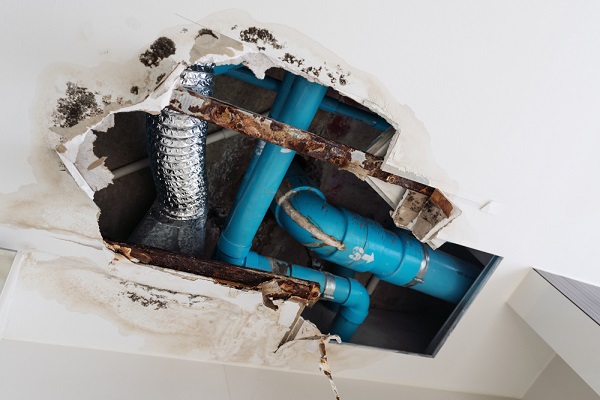How IoT Devices Prevent Water Damage

By: Robert Sullivan
Water damage is one of the most frequent and expensive property loss claims filed each year for commercial properties, including office buildings, industrial complexes, retail outlets, mixed-use developments and hotel properties.
Unfortunately, such claims have increased in both frequency and severity over the past few years. They cause billions of dollars in financial losses across the real estate industry with direct costs for cleanup, repairs, replacements and mold remediation, as well as indirect costs, such as legal fees, delayed projects or business interruptions, which wreak havoc on a real estate’s profit and loss statement.
A major factor in how severe the water damage can get is the number of stories in a building. As the number of stories increases, severity increases. A water leak from a top floor in a high-rise building can flow down several stories undetected and cause extensive damage. This is happening more frequently.
There are several strategies that real estate owners and property managers can employ to help prevent and mitigate the costs of water damage. These include creating a written water damage prevention plan and leveraging technology.
Proactively Preventing Water Damage
Despite how common water damage is in the real estate industry, only a small percentage of businesses have a written water damage prevention plan. However, creating a plan is critical to both preventing and mitigating water damage losses.
Several items to keep in mind when designing a water damage prevention plan include establishing a team and providing training, outlining pre- and post-event job responsibilities, identifying the location and properly labeling shut-off valves.
Real estate businesses should also enhance site inspection activities to include high-risk areas of potential water intrusion by identifying water intrusion prevention and control measures, as well as establishing post-event restoration and recovery strategies. In addition, they should identify and establish pre-event contracts with repair and remediation contractors and transfer risk contractually to responsible parties.
Finding areas at a high risk of water intrusion is one way to protect a business. Approximately 75% of all real estate industry property losses are due to accidental discharge related to plumbing, HVAC systems and appliances, according to 2014-2020 claims data from The Hartford. Some areas that can be more prone to water intrusion include interior systems such as piping, sprinklers, equipment and appliances. However, the building envelope—the roof, walls, and floors—as well as the exterior exposures, like landscaping, gutters and downspouts, can also impact losses due to water damage.
Real estate owners and managers should also pay attention to any pipes that are frozen or have erosion when doing building maintenance and be mindful that if the building is newly constructed, leaks and intrusions can happen because of a poor-quality plumbing installation. Also, they should regularly check the outside of the building and make sure no damage or deterioration could lead to water entering the building.
Using Technology to Prevent Water Damage
Technology can monitor and alert business owners to water leaks or intrusions. Property managers can install these detection systems in a part of the facility that has had a history of water damage.
If the system senses a leak, it can send an alert to a maintenance employee’s phone or computer to give them the chance to make necessary changes before the event turns into a costly claim. Water detection technology can also connect to control valves, so if there is a leak, the system can automatically shut off water to prevent any further damage.
Many carriers have dedicated teams of technicians that use Internet of Things (IoT) technology to help reduce potential losses at commercial properties. Using state-of-the-art devices connected to a network, property managers and maintenance staff can collect, share and act on information in real-time before a water event creates a costly issue.
Some examples of devices that can help prevent water damage include water sensors to detect the presence of water and send an email or text alert and flow monitoring systems that detect unexpected or unusual flows.
Automatic shut-off switches are triggered by a water sensor or flow monitor to stop inadvertent water flow, and temperature and humidity monitors detect potential mold conditions or identify potential freeze conditions before a pipe burst.
For example, if a business installed water sensors and automatic shut-off valves and a pipe begins to leak, it will activate a water sensor, which can then trigger the automatic valve to shut off to prevent more water from leaking. At the same time, the maintenance staff or property owner can receive an alert through email or phone letting them know about the leak. The key is that with IoT devices, the technology is always on the job to help protect business owners from water damage and intrusion.
Robert Sullivan is the real estate industry practice lead for The Hartford’s middle and large commercial segment.
The information provided in these materials is intended to be general and advisory in nature. It shall not be considered legal advice. The Hartford does not warrant that the implementation of any view or recommendation contained herein will: (i) result in the elimination of any unsafe conditions at your business locations or with respect to your business operations; or (ii) be an appropriate legal or business practice. The Hartford assumes no responsibility for the control or correction of hazards or legal compliance with respect to your business practices, and the views and recommendations contained herein shall not constitute our undertaking, on your behalf or for the benefit of others, to determine or warrant that your business premises, locations or operations are safe or healthful, or are in compliance with any law, rule or regulation. Readers seeking to resolve specific safety, legal or business issues or concerns related to the information provided in these materials should consult their safety consultant, attorney or business advisors. All information and representations herein are as of October 2021.










